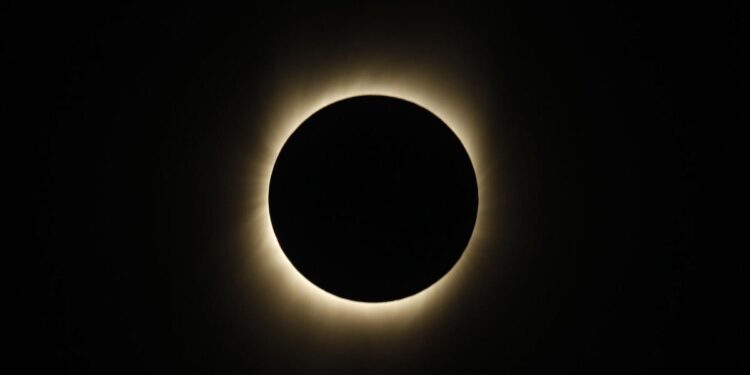Cloudy skies, protective eyewear and an afternoon to remember will pretty much sum up Monday.
On Monday, a total solar eclipse will pass through Southeastern Oklahoma and most of central Texas, with a partial eclipse in various parts of the country. The eclipse totality will pass over Idabel, Hugo and Antlers, as well as cities near Dallas, Texas.
Here’s what to know to prepare and enjoy this spectacular phenomenon.
What to know about the solar eclipse.
According to Astronomy.com, a solar eclipse is an alignment of the Sun, Moon and Earth, in that order. With the Moon directly between the Sun and Earth, it casts a shadow that has both an inner and outer part. The inner part is called the umbra and the outer part is the penumbra. If one is in the umbra, they’ll see a totality, which means that they’ll be in the path of the eclipse and completely see the shadow. If one is in the penumbra, they’ll see a partial eclipse. They won’t see the full eclipse, but if they wear the protective solar glasses, they can see the partial eclipse safely without damaging their eyes.
The website said all solar eclipses happen at the New Moon, but solar eclipses don’t happen at every New Moon because the Moon’s orbit tilts 5 degrees relative to Earth’s orbit. The Moon’s orbit intersects with Earth’s orbit in two places called nodes. Eclipses only happen when the Sun lies at one node and the Moon is either at the same node or at the opposite side of Earth. If the Sun and Moon are at the same node, there’ll be a solar eclipse. If they’re at different nodes, there’ll be a lunar eclipse. Most of the time, the Moon is either above or below one of the nodes and no eclipse happens..
How will the eclipse impact everyone, even nature?
Adam Moss, Graduate Research Assistant in the Physics and Astronomy Department at OU, said that during the eclipse, animals can easily be tricked.
“A lot of times, animals can be tricked by things,” Moss said. “It can get pretty dark when the eclipse happens. Animals may start thinking it’s nighttime so you may start hearing crickets chirping because they chirp at night. It’ll also be cooler because you’re blocking out the sunlight and the temperature is going to drop, even if you’re not in totality.”
How often does an eclipse like this happen?
Astronomy’s website said 2.38 solar eclipses of one kind or another occur each year on average. There must be at least two per year, but there can’t be more than five. More than 72 percent of all years have just two solar eclipses and only 0.5 percent have five.
The website said solar and lunar eclipses repeat more than 18 years. Scientists call this length of time a Saros cycle. However, a specific spot on Earth will take on average 375 years for it to be in totality. It depends on whether the spot is in the Northern or Southern Hemisphere. If it’s in the north, it happens, on average, about once every 330 years. If it’s in the south, it’s once per 540 years.
The website said each hemisphere sees more eclipses during the summer, when the Earth is tilted toward the Sun. Since Earth is at the farthest point in its orbit in July during the Northern Hemisphere summer, the Sun’s size is relatively small. This means that solar eclipses at that time are more likely to be total because the Moon is more likely to appear larger than the Sun.
Moss said the Moon’s distance from the Earth changes a little when it orbits around the Earth.
“When it’s farther away, the Moon is smaller in the sky and it doesn’t completely block the sun,” Moss said. “In this case, the Moon is a little bit closer to us.”
The website said that the last time Oklahoma saw totality was on June 8, 1918.
According to National Eclipse, the next time Oklahoma will be in totality is on August 12, 2045.
How does this year’s eclipse compare to 2017’s eclipse?
According to NASA, the path of totality will be much wider on Monday, compared to the eclipse in 2017. During the 2017 eclipse, the Moon was farther away from Earth than it will be on Monday. Because of the season, timing and the sizing of the Sun, the path of totality will be either small or large.
How strong will the totality be in Southwestern Oklahoma compared to Southeastern Oklahoma? What will the weather be like?
According to NASA, Lawton will get 93.9 percent coverage. However, the forecast, as of publishing, according to KSWO, will be 76 degrees and partly cloudy with a 20 percent chance of rain. Anyone can go to the link and put in their zip code to find information on how much coverage they’ll get.
Is the eclipse still visible behind the clouds?
According to Time, cloudy skies can dull the effects of total eclipses, making them less dramatic. If it’s just an overcast or partly cloudy day, Patricia Reiff, a Professor of Physics and Astronomy at Rice University and a veteran solar eclipse traveler, said light clouds have a tendency to thin out as totality starts due to the way the sunlight is scattered. The ability to view an eclipse during cloudy weather depends on the extent of the clouds.
Which areas in Oklahoma have the best view?
Doris Biegler, STEM Coordinator and Technology Trainer at Lawton Public Schools, said in a previous interview with The Lawton Constitution, that anyone wanting to see the eclipse can do so, but will not get to see the full darkness. The best area to see the eclipse in Oklahoma is in the southeast, like Antlers and Idabel.
“If you want the full darkness, you have to go through the path,” Biegler said. “In Oklahoma, one of the closest places that we have is in Antlers.”
Bill Fudge, a local astronomer, said he’s driving close to McKinney, Texas, where there will be a total solar eclipse.
What time will it start?
According to NASA, the eclipse will start at 12:24 p.m., be at maximum partial capacity at 1:42 p.m., and end at 3:01 p.m.
Should Oklahoman’s take any travel or safety precautions for it?
Biegler, Fudge and Moss all stressed the importance of wearing solar glasses.
Moss said anyone who wants a better view of the eclipse can go to Southeastern Oklahoma, toward the very corner of the border between Oklahoma, Arkansas and Texas, and see totality.
“If you want to travel down to Texas, in Dallas, for example, it’s going to be right in the middle of the totality,” Moss said.
How important is it to wear the solar glasses?
Biegler stressed the importance of wearing the solar glasses.
“If anybody looks at the sun directly, even during an eclipse, the sun’s radiation and brightness is still so strong that it can burn their retinas and mess up their vision if they look at it for any length of time,” Biegler said. “With the eclipse, a lot of people think that because it’s blocked they can look at it, but there’s still the corona, which is the outside ring. Never, ever look at the sun directly, unless you are using the actual certified solar eclipse glasses.”
Fudge said Lawtonians need to wear solar protection.
“Solar glasses block out 99.9 percent of light,” Fudge said. “With this partial solar eclipse, it’s still going to be so bright it will damage your eyes. Anybody in the Lawton area who’s going to look at the solar eclipse needs to use solar glasses.”
Where can one get the glasses?
Biegler said in the article that anyone can buy solar glasses anywhere, as long as they are certified with the safety number “ISO.” If they don’t have one or haven’t been inspected, they aren’t certified as “actual solar glasses.”
“These are so dark, that if you look through them, you can’t see anything,” Biegler said. “It’s almost like welding goggles. The only time you can see anything through it is if you have something very bright, like the sun.”
Is taking a photo of the eclipse with a phone a good idea?
According to BGR, taking a photo of the sun or eclipse with a phone or camera is like staring at the sun or eclipse without protective sun glasses. The reason for this is that the lenses in a phone and camera aren’t designed to filter out the intense solar rays the Sun shines out. Using a camera or phone would cause the heat from the rays to become so concentrated that it could melt the lens inside. Using binoculars or a telescope to look closer at the eclipse could essentially melt one’s eye.
In order to safely take a photo of the Sun or eclipse, one must have a special filter to help protect their eyes and lenses on their cameras from the Sun.
Want to reach a local audience and grow your business?
Our website is the perfect platform to connect with engaged readers in your local area.
Whether you're looking for banner ads, sponsored content, or custom promotions, we can tailor a package to meet your needs.
Contact us today to learn more about advertising opportunities!
CONTACT US NOW




